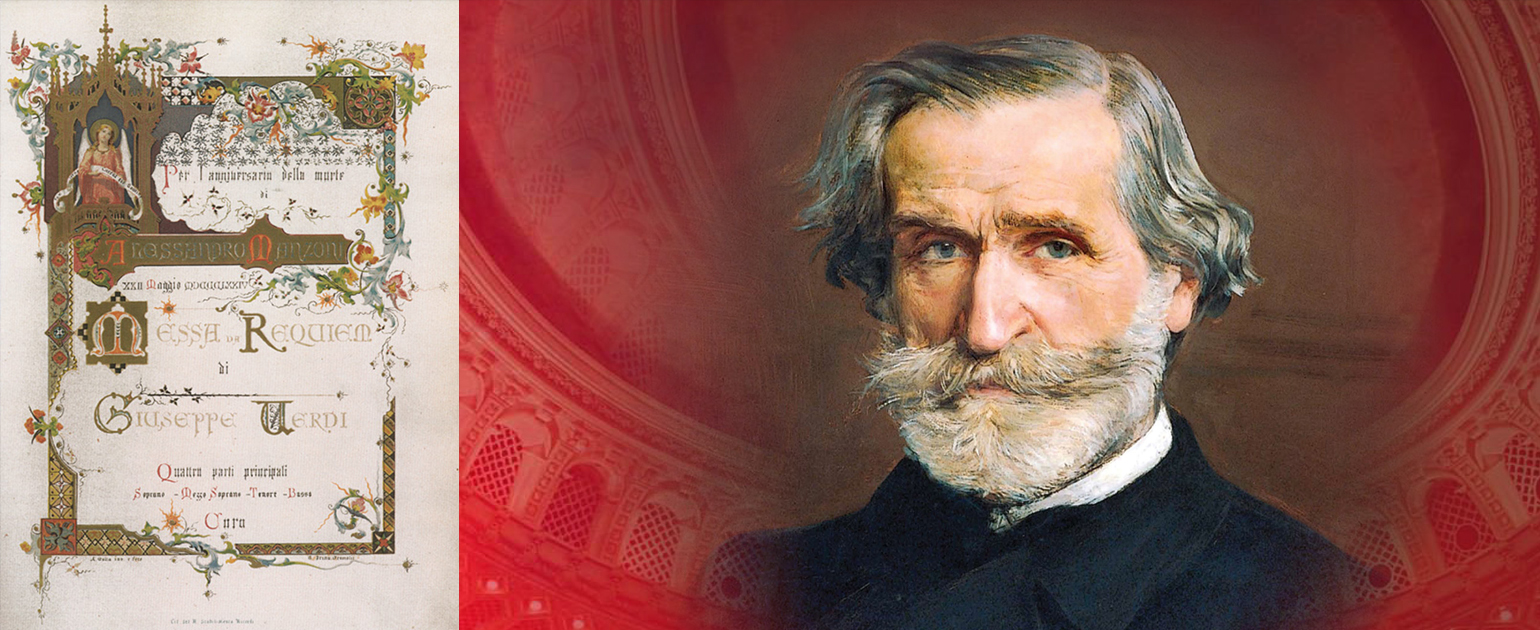The concept of the Requiem relates to the end of 1868; Rossini’s death inspired Verdi to pay homage to the memory of “the most respected Italian composer”. The idea was the best composers of the time to unite and write a funeral mass on the occasion of the Anniversary of Rossini’s death. By lot Verdi was entitled to write the concluding movement, in principle the most attractive for the composers – Libera me. This Requiem was written in November 1869, but anyway it was never performed.
Later Verdi decided to write his own Requiem in Rossini’s honour; the work over it, however, was running slowly; as a stimulus for its faster completion (at that time Verdi had already composed several movement) served the death of the eminent writer Alessandro Manzoni (22 May 1873), whom Verdi admired still since the years of his youth, considering him for a “model of virtue and patriotism”.
Verdi finished his Requiem on 10 April 1874. Its first performance took place in the year of Manzoni’s death – on 22 May the same year, in the Milan’s San Marco Cathedral; on the conductor’s stand stood the author himself. After several days, the Requiem with great success was performed at La Scala di Milano, with the same success in 1875 passed the premieres under the baton of the author the premieres in Paris, London and Vienna, and after that in Munich, in Petersburg too …
On the composer’s own confession, initially he took for model Luigi Cherubini’s Requiem in C minor, a composition for chorus, without soloists, in which to the orchestra as a whole was assigned a quite humble role – but in the work process Verdi deviated too much from this model: in his Requiem, in addition to the big four-voice chorus and the full symphonic orchestra, are present also four soloists: soprano, mezzo-soprano, tenor and bass. In style, with the numerous ariosos and ensembles – duets, terzets and quartets – with the really Italian opera cantilena, Verdi’s Requiem reminds more of his late operas, most of all of “Aida”, than of Cherubini’s work and the works of others of his predecessors. The role of the orchestra in this Requiem goes far out the frames of the ordinary accompaniment.
Maybe because of the fact that Manzoni’s death was for Verdi an enormous personal loss, he created a deeply dramatical work, with the sharpness of the experiences, inherent to Romanticism, clearly distinguishing itself even from his own, written later, “Four Sacred Pieces”, consistent in a strict, absolutely “church” style. In the Requiem of this style reminds only Agnus Dei.
His Requiem Verdi wrote on a canonical Latin text, this is why in the Sequence before its last movement – Lacrimosa, by Verdi is repeated the first movement – Dies irae, the terrifying scene of the Day of Atonement and once again Dies irae sounds in the concluding movement – Libera me; this way the Day of Judgement theme is interweaved in the entire Requiem, which is not a rule of the canon; as some musicologist suppose, for Verdi this is not the Day of Atonement in itself, but the merciless invasion of death, yielding only in the lyrical, appeased movements of the Requiem, in which the composer imputed his entire melodical talent.
The “operatic sounding” of this Requiem still at its first performances evoked disputes, not ceasing even to this day: in which way the inclusion of elements from the opera has reflected on the work’s liturgical style – did it harm it or it made it more perfect?…
In Europe Verdi’s Requiem won audience at once; after the words of eyewitnesses, invariably it was enthusiastically applauded, some of the movements were performed for the second time. Besides, outside Italy the attitude towards the Requiem in some countries was, and partially remains dual up to this day: it is considered for a work, belonging rather to the opera genre, than for a liturgical one, and it is being performed as an emblematic, exceptional music drama; to such extent that the Requiem, like an opera, gets divided into Act I and Act II. According to opinions of critics, so far only the best Italian conductors – to begin with Arturo Toscanini (to him belong also the first recording of the work of art – on 27 May 1938 in London with the ВВС Orchestra) and Carlo Maria Giulini – succeeded to bring out to the surface the religious feeling in Verdi’s work, to make it sound namely like a funeral mass.
One way or another, together with Mozart’s Requiem, Verdi’s Requiem is one of the most performed works in this genre.

19 Mar 2019Sofia Opera and Ballet